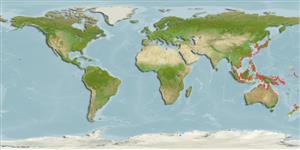Common names from other countries
Classification / Names / Names
आम नाम | उपशब्द | Catalog of Fishes (gen., sp.) | ITIS | CoL | WoRMS
Environment: milieu / climate zone / depth range / distribution range
पारिस्थितिकी
; गहराई सीमा 0 - 20 m (Ref. 348), usually 0 - 20 m (Ref. 75831). Tropical
Western Pacific: from the Malay Peninsula to the Philippines; north to Japan and south to northern New South Wales.
Length at first maturity / आकार / वज़न / Age
Maturity: Lm ? range ? - ? cm Max length : 7.5 cm SHL पुल्लिंग / अलिंग; (Ref. 348); common length : 6.0 cm SHL पुल्लिंग / अलिंग; (Ref. 348)
Collected locally for food in southeast Asian countries where the species is common (Ref. 348). Found in intertidal areas in sand (Ref. 75831). Occurs at low tide mark (Ref. 799).
Life cycle and mating behavior
परिपक्व अवधि | पुनरुत्पत्ति | मछलीऔ का अंडे देना | अंडे | Fecundity | लार्वा
Members of the class Bivalvia are mostly gonochoric, some are protandric hermaphrodites. Life cycle: Embryos develop into free-swimming trocophore larvae, succeeded by the bivalve veliger, resembling a miniature clam.
Poutiers, J.M. 1998. (Ref. 348)
IUCN Red List Status (Ref. 130435)
CITES status (Ref. 108899)
Not Evaluated
Not Evaluated
Threat to humans
Harmless
Human uses
| FishSource |
साधन
अधिक जानकारी
Age/Size
बाढ़
Length-weight
Length-length
आकृति विज्ञान
लार्वा
बहुतायत
इंटरनेट स्रोत
Estimates based on models
Preferred temperature
(Ref.
115969): 18.8 - 29.1, mean 27.9 (based on 1066 cells).
Vulnerability
Low vulnerability (10 of 100).
Price category
Unknown.
